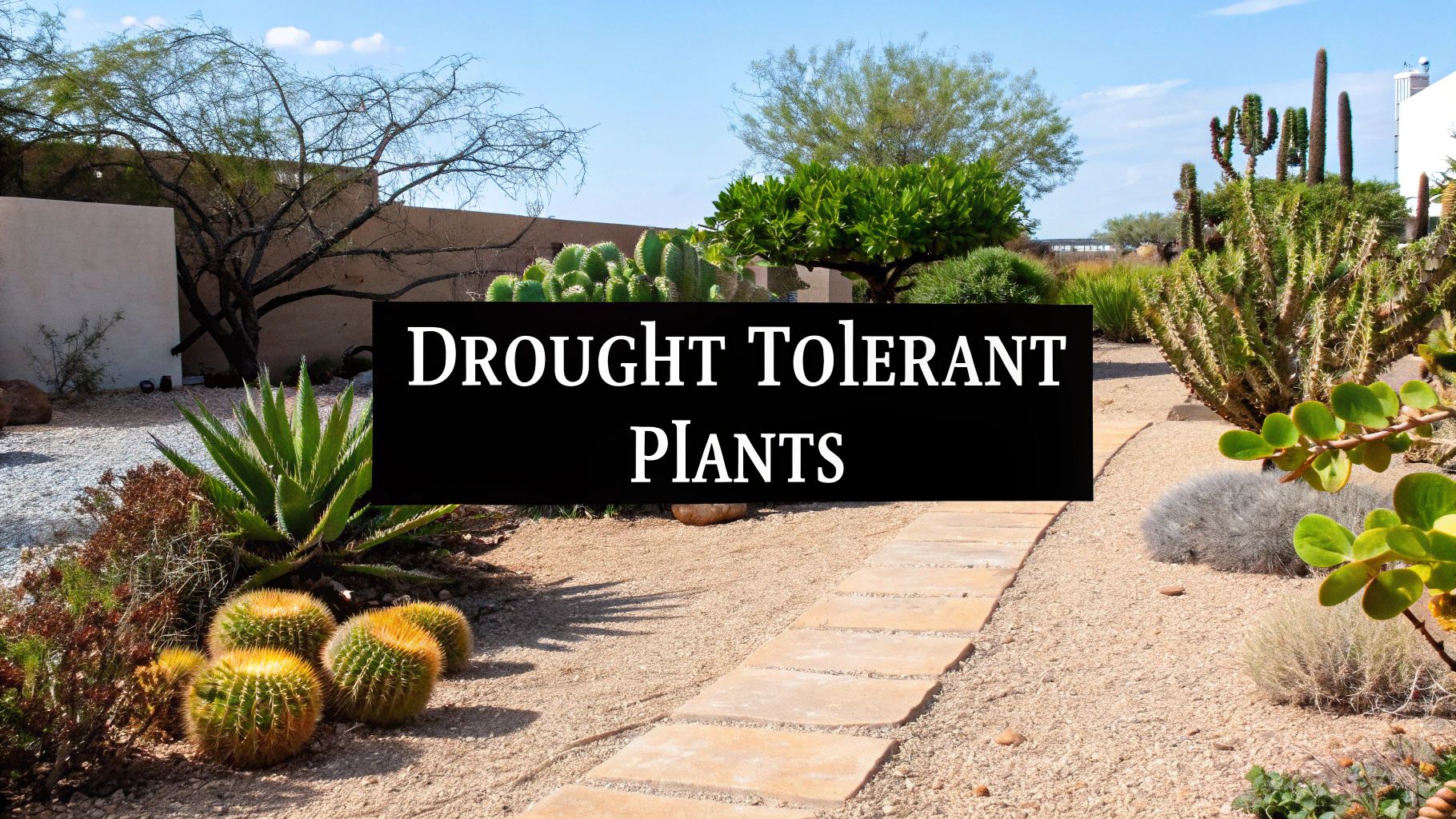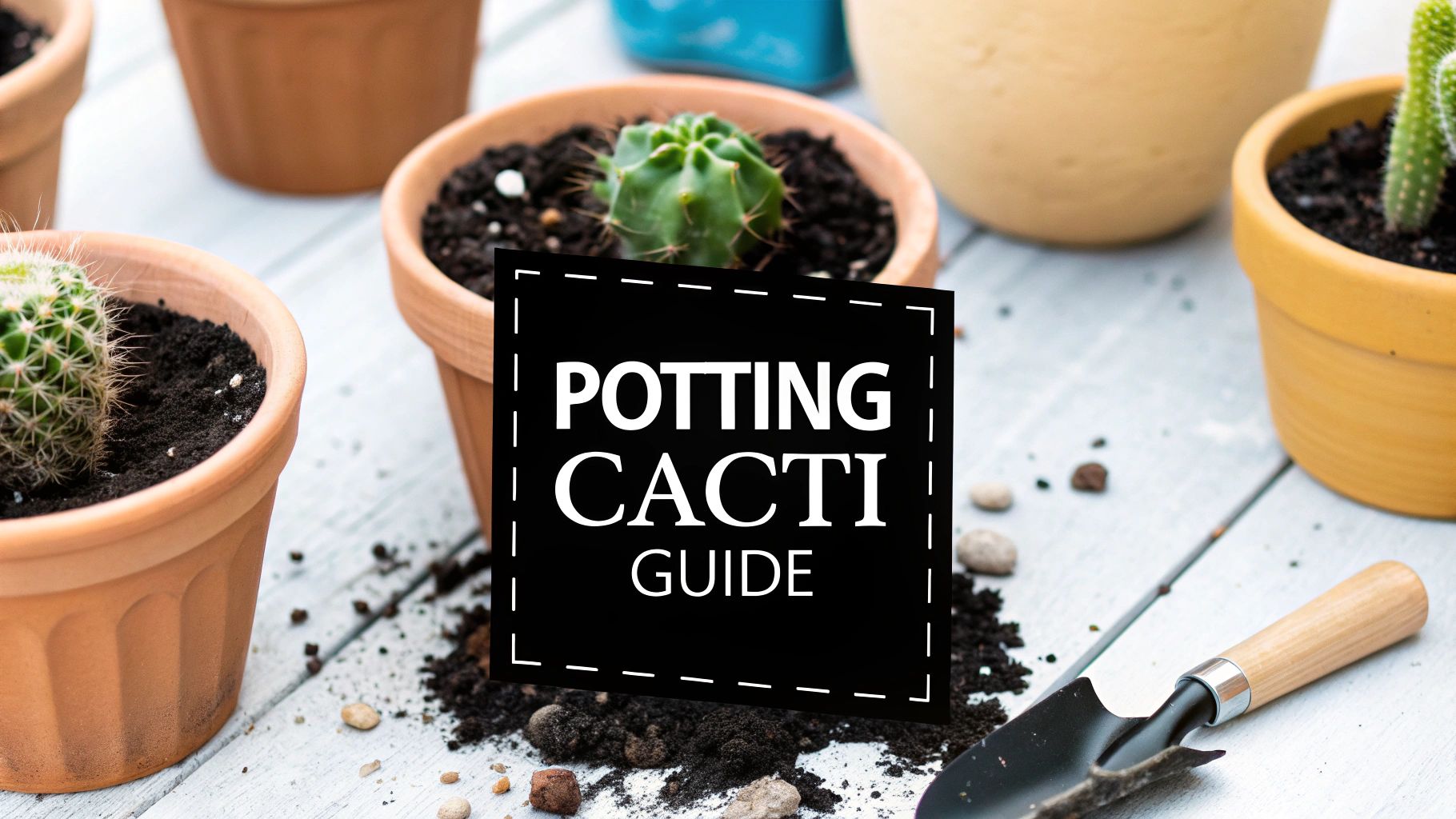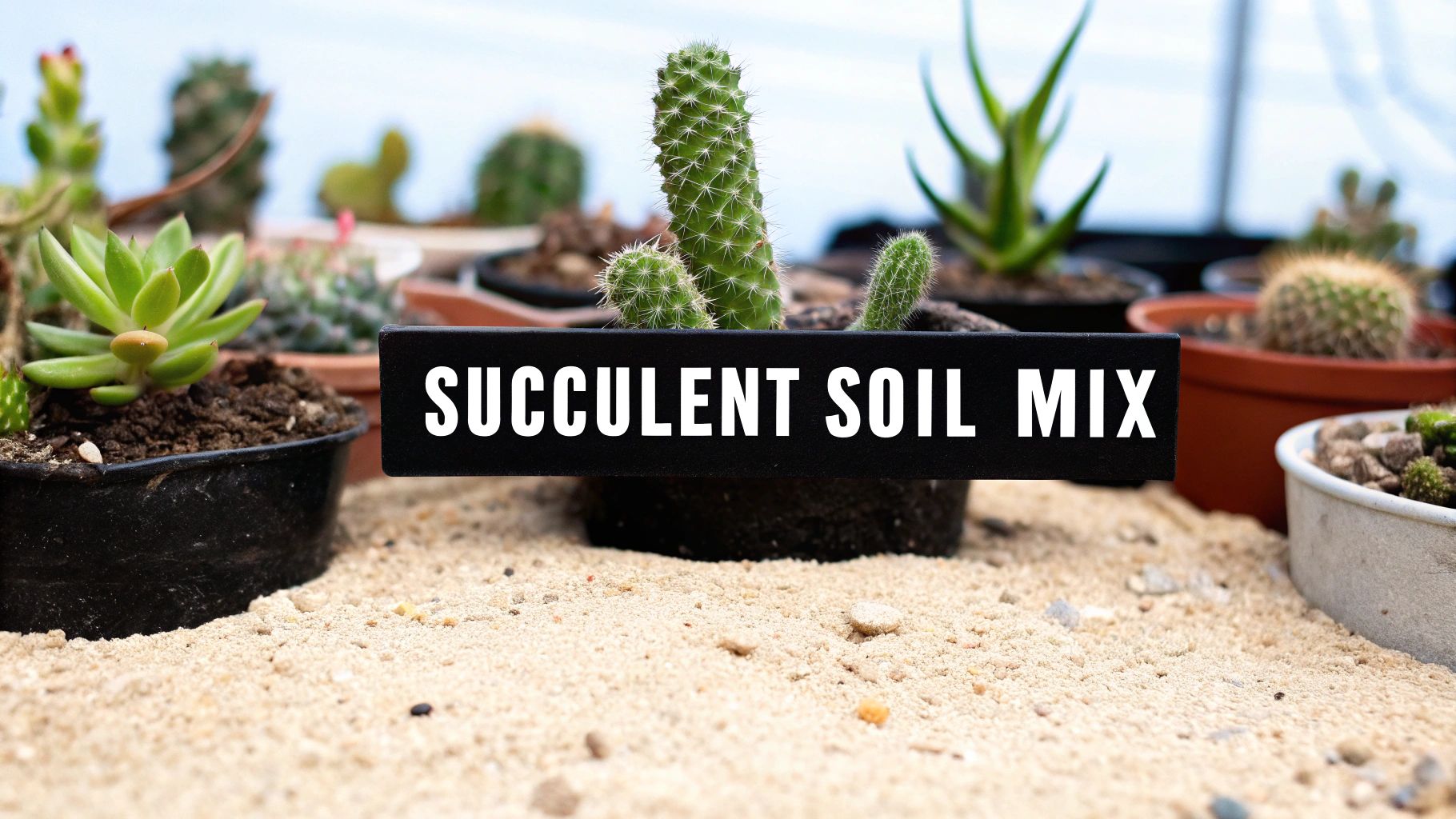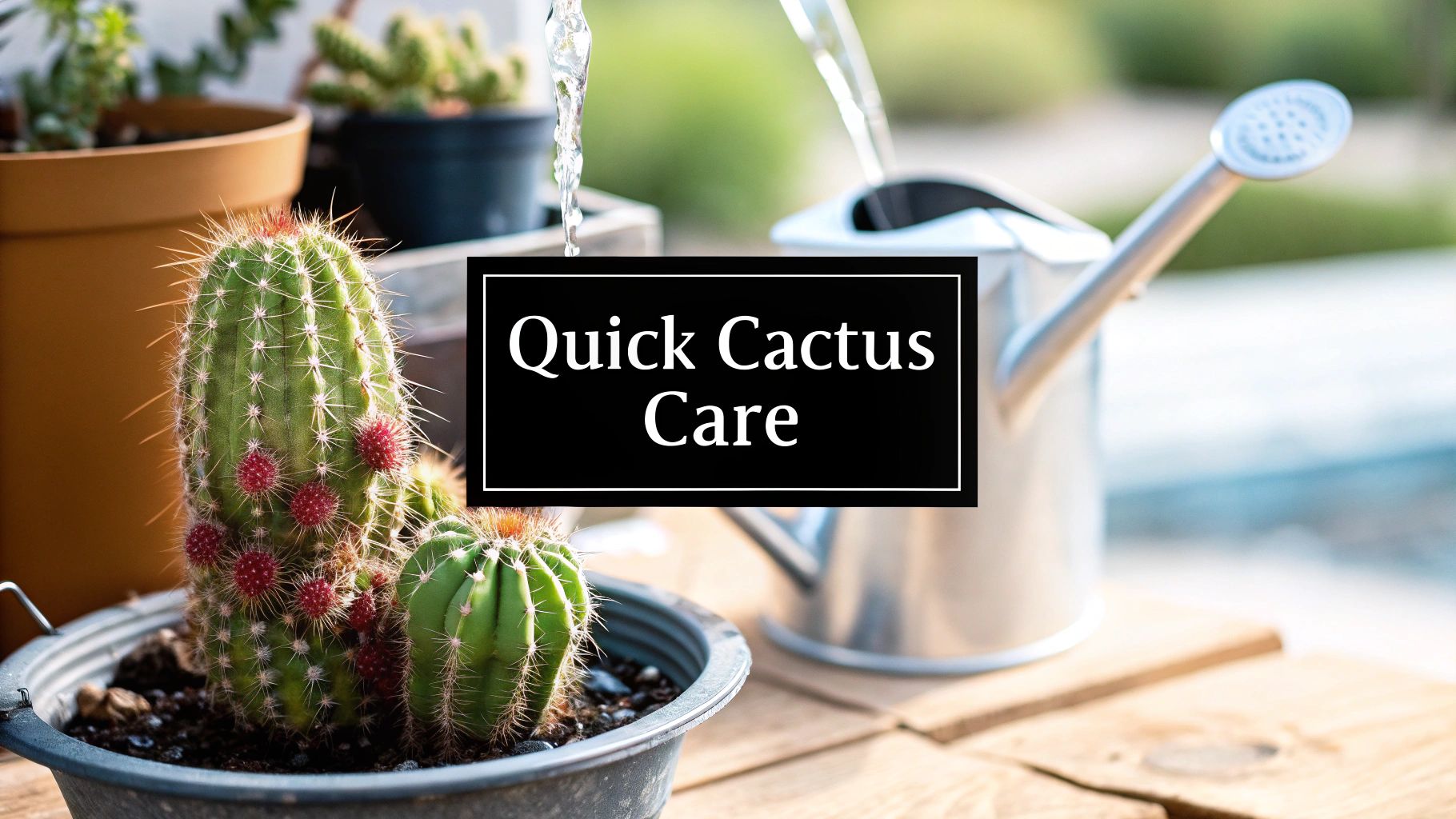When you hear "drought-tolerant landscaping," what comes to mind? For many, it's a stark image of rocks and a few lonely cacti. But the reality is so much richer and more beautiful. These are simply plants that have cleverly adapted to thrive with minimal water, making them perfect for creating stunning, low-maintenance gardens that are anything but barren.
Think of it as swapping out a needy, thirsty lawn for a self-sufficient ecosystem of succulents, native perennials, and ornamental grasses. The result? A dramatic drop in your water usage and a welcome break from endless weekend yard work.
Beyond Saving Water: The Real Payoff
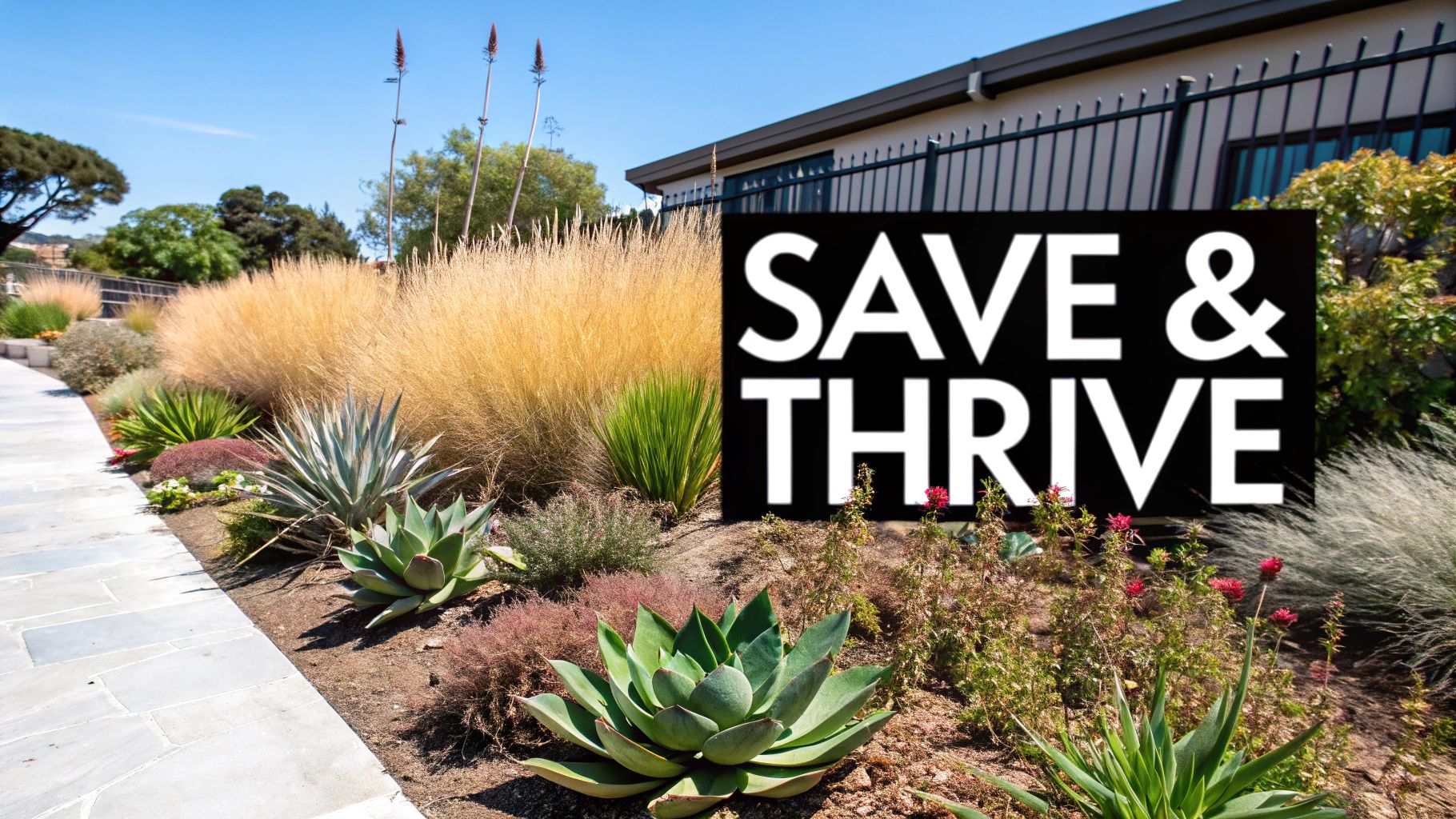
Sure, the most obvious win with drought-tolerant plants is water conservation. But the benefits ripple out much further than just a lower utility bill. When you adopt a water-wise approach, you fundamentally change your relationship with your yard—it shifts from a source of constant labor to a place of sustainable enjoyment.
This isn't about giving up on a lush, vibrant outdoor space. It's about making a strategic upgrade that builds a more resilient and beautiful landscape that works with nature, not against it.
Slash Your Bills and Win Back Your Weekends
Let's talk about the practical side of things first. A well-planned, water-wise garden can put a surprising amount of money back in your pocket and time back in your day. By replacing huge patches of thirsty turfgrass with plants that are actually suited for your local climate, you can slash your irrigation needs.
This is a big reason drought-tolerant landscaping has caught on. Switching to these kinds of plants can cut your outdoor water use by up to 75%. That's a massive deal, especially when you consider that about 40% of the land in many areas regularly faces drought conditions.
The core idea is simple: work with your local environment. When you do, you spend far less time watering, mowing, and fertilizing. That reclaimed time is yours to actually enjoy your garden, not just maintain it.
Boost Your Home's Value and Curb Appeal
A thoughtfully designed landscape does more than just look pretty—it adds real, tangible value to your home. A garden that showcases unique textures, striking forms, and pops of color creates an unforgettable first impression that makes your property stand out.
Beyond the smart economics and eco-friendly perks, a low-water garden can seriously elevate your home’s aesthetic. If you're looking for more inspiration on how to improve curb appeal and boost home value through landscaping, this is a great place to start.
A smart, water-wise landscape delivers on multiple fronts:
- Unique Aesthetics: You get to play with a huge variety of plant shapes, sculptural forms, and fascinating textures you just don't find in a traditional lawn.
- Year-Round Interest: Many drought-tolerant species look fantastic through every season, providing color and structure even in the dead of winter.
- Built-in Resilience: Your garden will continue to look great even during a dry spell, unlike a traditional lawn that gets brown and stressed.
Ultimately, choosing drought-tolerant plants is a smart investment. You're creating a more sustainable, vibrant, and surprisingly low-effort outdoor space that pays you back in beauty, time, and money.
Designing Your Low-Water Oasis
A breathtaking, low-water garden is never an accident. It all starts with a smart plan. Before you even think about heading to the nursery, the most critical step you can take is to get to know your own property. This initial design phase is what guarantees the drought tolerant landscaping plants you pick will do more than just survive—they'll absolutely flourish.
Think of your yard as a canvas made up of smaller, unique environments. Take a day, grab a notebook, and just watch how the sun moves across your space. Where does that intense afternoon sun bake the ground? Are there cool pockets that stay shady most of the day? This simple act of observation is your first step to mapping out your property’s "microclimates."
Understanding Your Canvas
Every yard has its own personality, shaped by sun, soil, and the way water moves through it. Pinpointing these characteristics is like drawing up a blueprint for the beautiful garden you're about to create.
- Sun Mapping: Sketch out your yard and mark the areas that get full sun (6+ hours), partial shade (3-6 hours), and full shade. A sun-worshipping Agave is going to languish in a dark corner, just as a delicate Heuchera will get fried out in the open.
- Soil Assessment: Don't be afraid to get your hands dirty. Dig a small hole and really feel the soil. Is it sandy and gritty, letting water rush right through? Or is it heavy, clumpy clay that holds onto every drop? Most cacti and succulents are non-negotiable on this point: they need excellent drainage to keep their roots from rotting.
This infographic gives a fantastic overview of key design principles, from comparing water usage to organizing your garden based on sun and watering needs.
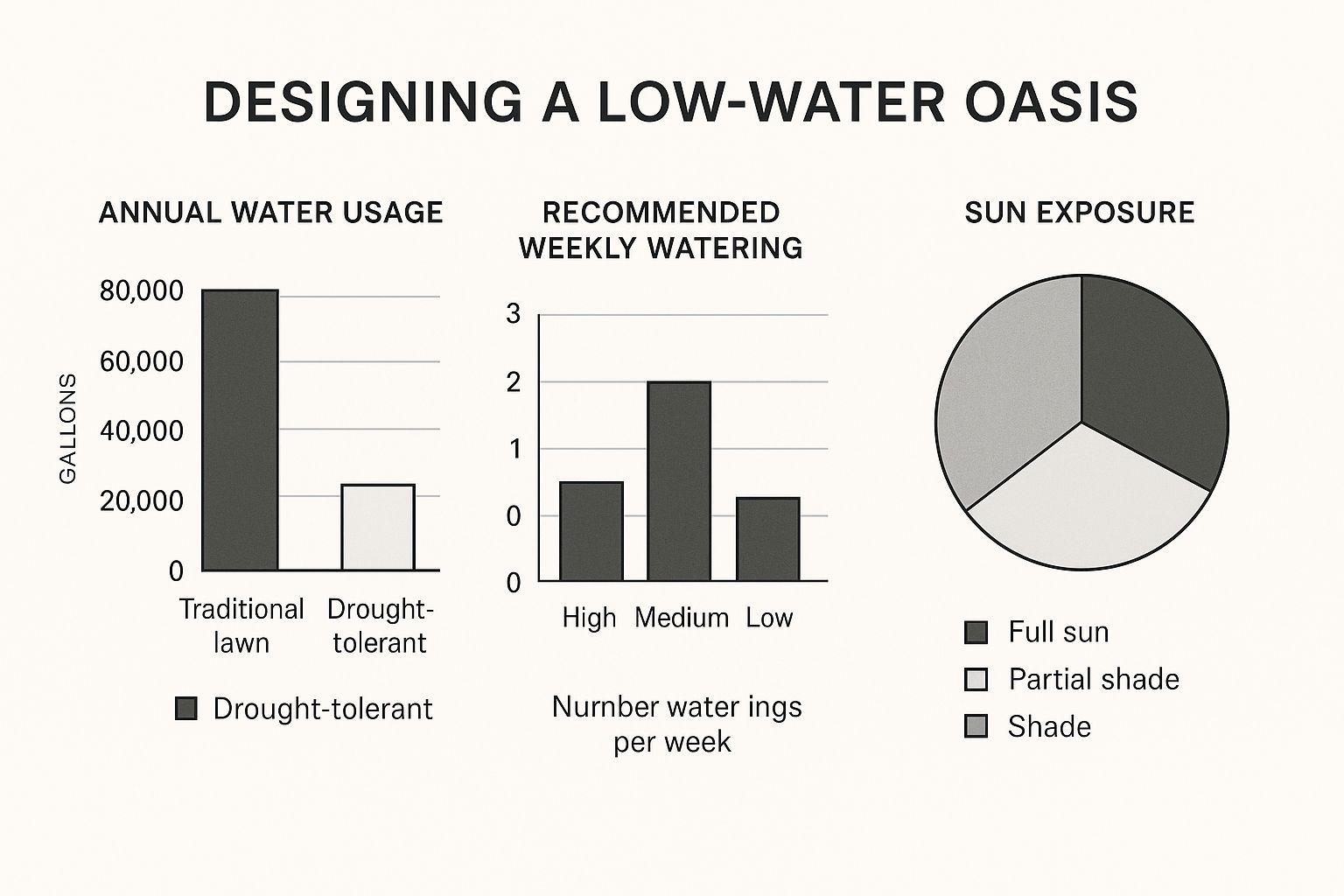
The numbers don't lie—the water savings are dramatic. It also highlights why grouping plants with similar needs is the secret to a healthy, low-fuss landscape.
Grouping Plants with Hydrozoning
Once you have a feel for your yard’s conditions, you can put one of the core principles of xeriscaping into practice: hydrozoning. It sounds technical, but it’s really just common sense—grouping plants with similar water needs together. By creating these distinct zones, you can water far more efficiently, never drowning your desert natives or leaving your thirstier accent plants to dry out.
A "low-water zone," for instance, might be home to tough-as-nails succulents like Sedum and Echeveria that are happy with a drink every few weeks. A nearby "moderate-water zone" could feature flowering perennials like Lavender or Russian Sage that perform best with a bit more moisture. This simple strategy stops you from making the classic mistake of giving every plant the same amount of water.
Grouping plants based on their water requirements takes the guesswork out of the equation. You end up with a self-sustaining system where every plant gets exactly what it needs to thrive.
Creating Visual Interest with Texture and Color
Let's clear something up: a water-wise garden can be incredibly lush and vibrant. The trick is to think beyond just flowers. You want to create contrast by playing with different forms, textures, and heights. It’s this combination of elements that makes a garden look full, intentional, and interesting all year long.
For a little creative spark, take a look at these incredible drought-tolerant landscaping ideas and see what's possible.
Here are a few combinations I love to use:
- Spiky and Soft: Pair the sharp, architectural form of a Yucca with the soft, flowing texture of an ornamental grass like Blue Fescue. The contrast is stunning.
- Bold and Fine: Set the massive, fleshy leaves of an Agave against the delicate, airy foliage of a groundcover like Trailing Lantana.
- Vertical and Spreading: Use a tall, columnar cactus like the Peruvian Apple to draw the eye up, then surround its base with low, spreading Sedums to carpet the ground.
This thoughtful approach to design does more than just save water. It transforms a random collection of plants into a cohesive, beautiful, and resilient oasis that will add so much value and enjoyment to your home.
Picking the Perfect Plants for Your Region
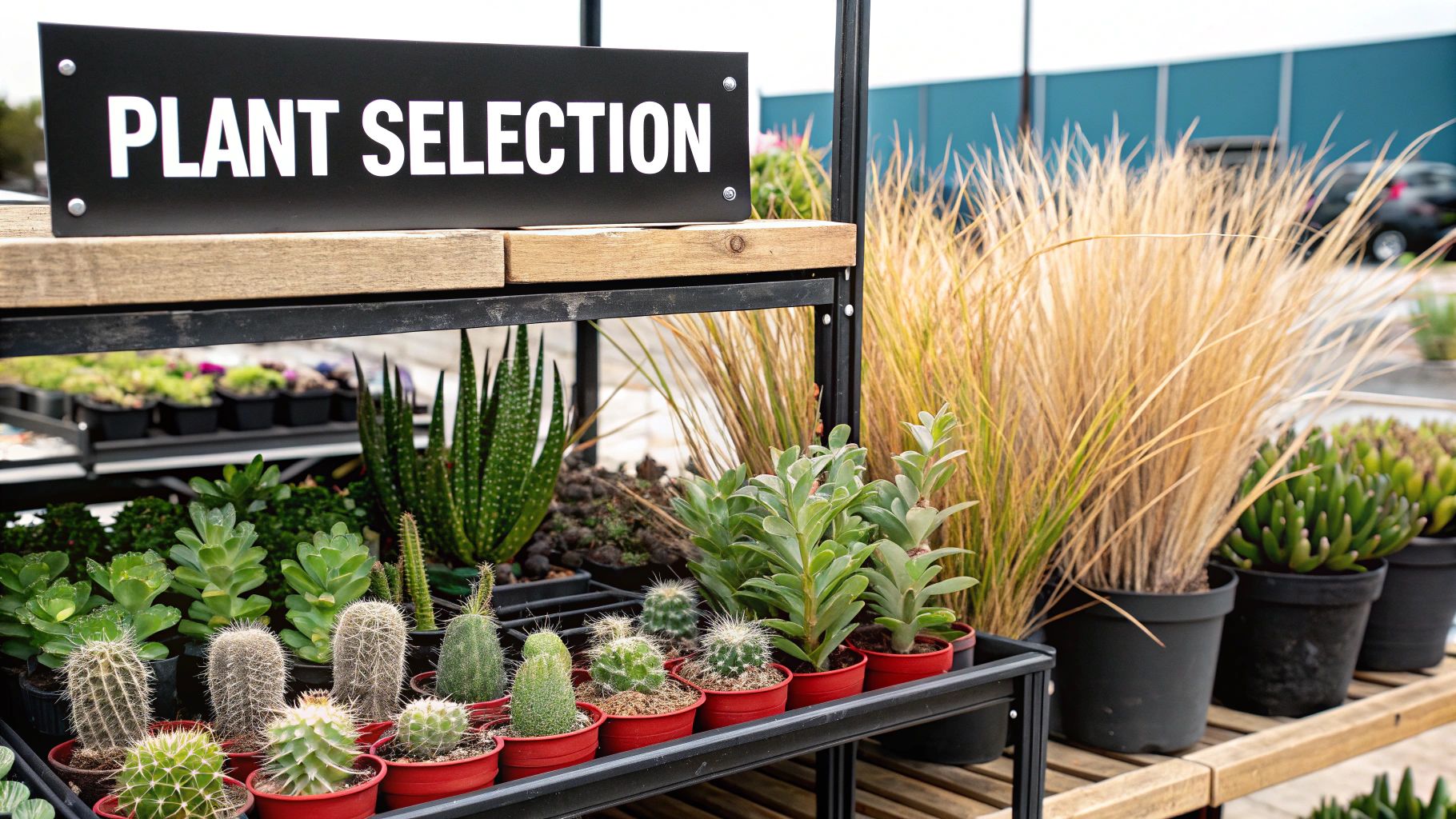
Okay, this is where the fun really begins. You’ve got your plan, so you can walk into the nursery with confidence, ready to look past the generic plant tags and find the real gems.
Your goal isn't just to grab what looks pretty. It's to assemble a team of drought tolerant landscaping plants that are genetically wired to thrive in your specific climate and soil. It’s all about matching their needs—sun, soil, and water—to the conditions you already mapped out in your yard. This one step is what separates a struggling garden from a stunning, practically self-sufficient landscape.
The Power Trio: Succulents, Grasses, and Natives
The backbone of nearly every successful water-wise garden I’ve seen is a smart mix of succulents, ornamental grasses, and native perennials. Each group brings something special to the design, creating a landscape that’s rich in texture, color, and form.
- Succulents: These are the undisputed champions of water conservation. Their fleshy leaves are designed to store moisture, which means plants like Agave, Echeveria, and Sedum give you incredible architectural shapes with very little fuss. Just give them bright sun and soil that drains fast, and they’re happy.
- Ornamental Grasses: Think of plants like Blue Fescue or Muhly Grass. They bring movement and softness to the garden, a perfect counterpoint to the rigid forms of many succulents. Once they're established, they are incredibly tough and almost never need extra water.
- Native Perennials: These are the local experts. Plants that are native to your region, like Coneflower or Black-Eyed Susan in many parts of the country, are already perfectly adapted to your local rainfall and soil. As a bonus, they provide essential food and habitat for local pollinators.
The demand for these kinds of plants is exploding. The global landscaping products market was valued at USD 88.64 billion in 2024 and is expected to climb to USD 129.98 billion by 2030. This growth is overwhelmingly driven by homeowners looking for water-efficient solutions.
A Plant Selection Cheat Sheet
To help you navigate the nursery and choose the right plants for your garden, here is a quick comparison of some popular options. This table breaks down their basic needs and highlights what makes each one special, making it easier to visualize how they might fit into your design.
Comparing Popular Drought Tolerant Plants
| Plant Name | Type (Succulent, Grass, etc.) | Sun Needs | Mature Size | Key Feature |
|---|---|---|---|---|
| Agave | Succulent | Full Sun | 2-6 ft. tall/wide | Dramatic, architectural shape |
| Echeveria | Succulent | Full to Part Sun | 4-12 in. tall | Rosette-forming, variety of colors |
| Blue Fescue | Ornamental Grass | Full Sun | 1 ft. tall/wide | Fine, blue-gray foliage clumps |
| Pink Muhly Grass | Ornamental Grass | Full Sun | 3 ft. tall/wide | Airy, pink flower plumes in fall |
| Coneflower (Echinacea) | Native Perennial | Full to Part Sun | 2-4 ft. tall | Daisy-like flowers, attracts birds |
| Trailing Lantana | Perennial Groundcover | Full Sun | 1 ft. tall, 3-5 ft. wide | Sprawling habit, constant blooms |
Picking from a list like this, you can start to see how different textures and forms can work together to create a dynamic and visually interesting garden that doesn't rely on constant watering.
Creating High-Impact Plant Combinations
The real magic happens when you start pairing these plants. A great combination is all about playing with contrast and harmony. Try placing a sculptural, blue-green Agave right next to the soft, feathery texture of a Pink Muhly Grass. The visual tension between the two actually makes each plant stand out more.
Another pairing I love is a low, spreading groundcover like Trailing Lantana at the base of a tall, columnar cactus. This creates layers of interest, drawing your eye from the ground all the way up. Don't be shy about playing with color, either—the deep purples of some succulents look incredible next to the vibrant yellows of a native daisy. For more ideas, you can explore our detailed guide on the best drought-tolerant plants to get your creativity flowing.
Pro Tip: Repeat certain plants or colors throughout your landscape. This creates a rhythm and sense of cohesion, making the whole garden feel intentional and unified, not just like a random collection of plants.
Questions to Ask Before You Buy
It's easy to get overwhelmed at the nursery. Keep these questions in mind for every single plant you consider to make sure it’s a good fit for your low-water oasis.
- What are its sun requirements? Check this against the sun map you made. "Full sun" isn't a suggestion—it means at least six hours of direct, unfiltered sunlight per day.
- What kind of soil does it need? Look for keywords like "well-draining," "sandy," or "gritty." If your soil is heavy clay, you’ll either need to amend it or choose plants that can handle it.
- How big will it get? Read the tag carefully. That cute little 1-gallon shrub could easily grow into a monster that smothers its neighbors in a few years. Plan for its mature size.
- Is it native or adapted to my region? Prioritizing plants that are from your area is always the smartest bet for building a truly resilient and eco-friendly garden.
By focusing on these simple, practical details, you'll bring home a team of plants that won't just survive—they'll shine.
Getting Your New Garden in the Ground
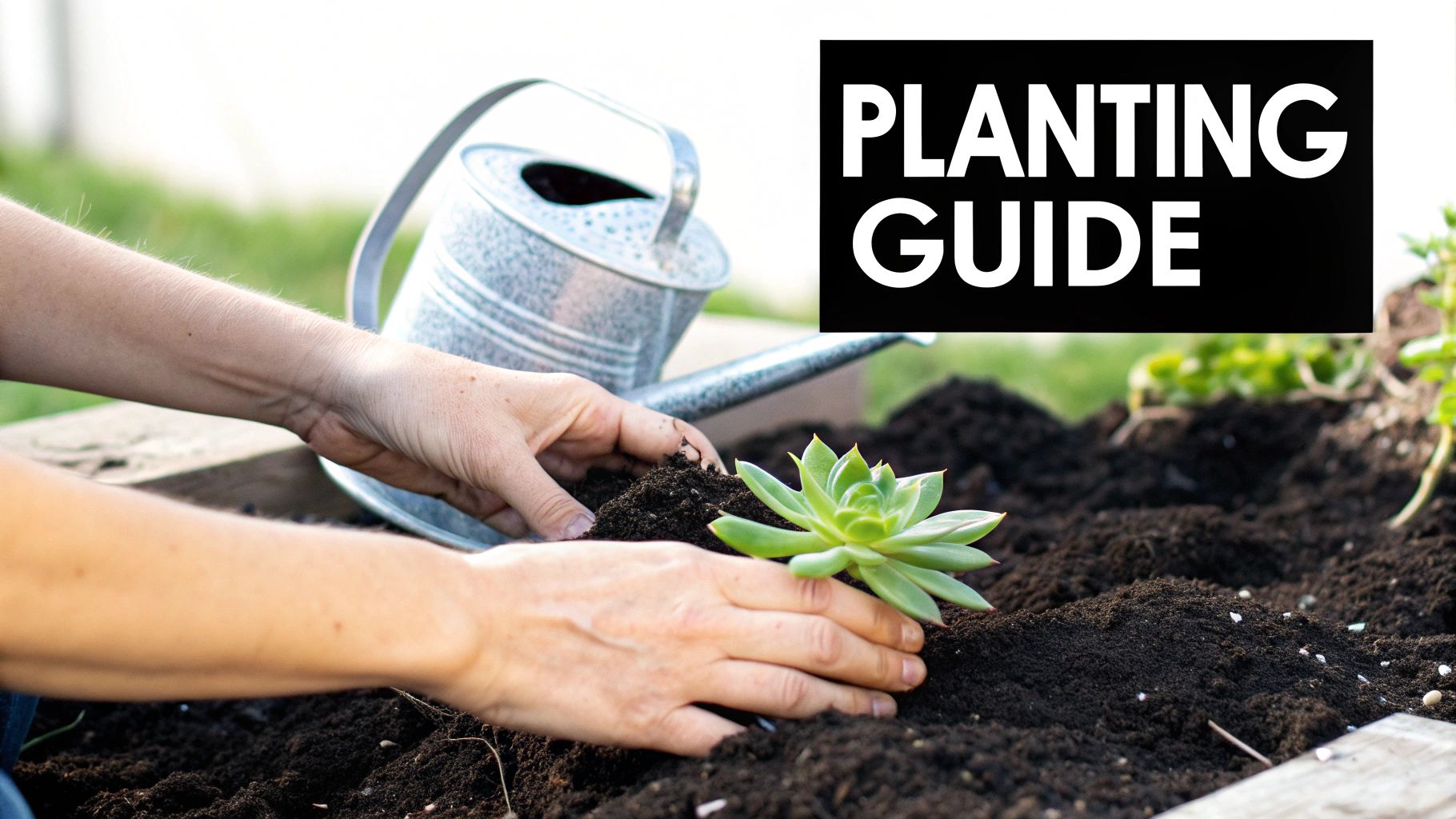
Alright, you’ve done the planning and picked out your plants. Now for the best part: getting your hands dirty and bringing that vision to life.
Planting cacti and succulents isn't hard, but it’s a world away from planting thirsty annuals. We’re not just trying to get them to survive; we’re setting them up for a lifetime of resilience by encouraging deep, strong roots from the very beginning.
Timing is everything. Trying to plant in the dead of summer is a recipe for stress, forcing your new plants to fight for their lives against the scorching heat. Do yourself (and your plants) a favor and aim for the milder weather of fall or spring. This gives them a comfortable window to settle in and establish their roots before the real heat kicks in.
Creating the Perfect Foundation
If there's one golden rule for drought tolerant landscaping plants, it's that they demand excellent drainage. Cacti and succulents absolutely despise "wet feet." Heavy, dense clay soil that traps water is their mortal enemy and a fast track to root rot.
If you discovered your native soil is heavy clay, you've got to amend it. This isn't optional.
You can transform that dense soil by mixing in a blend of organic and inorganic materials. A solid mix involves adding plenty of good compost for nutrients, along with one or more of these drainage boosters:
- Pumice: This stuff is fantastic. It's a lightweight volcanic rock that creates little air pockets, preventing compaction.
- Coarse Sand: Not playground sand! You want gritty, coarse sand to help break up the fine clay particles.
- Pea Gravel: For larger plants like agaves or big aloes, mixing some pea gravel into the bottom of the planting hole can add another layer of drainage insurance.
Think of this as an investment in your garden's future. It’s some extra work now, but getting the soil right is the most critical step for ensuring your plants thrive for years to come. This idea isn't just for home gardeners; it's a global shift. The market for drought-tolerant seeds is expected to hit USD 192.2 million by 2035, a clear sign that we're all looking for smarter ways to garden in a changing climate. You can read more about the growth of this market and its impact.
Proper Planting and Watering Techniques
With your soil prepped and ready, it's time to plant. The key here is how you water after planting. Your goal is to train the roots to dive deep for moisture, which is what will make them so tough and self-sufficient down the road.
Dig a hole that's about twice as wide as the nursery pot but no deeper than the root ball itself. Gently slide the plant out of its container and place it in the hole. You want the top of the root ball to be level with, or even a tiny bit above, the surrounding soil. Backfill the hole with your amended soil mix, tamping it down lightly to get rid of any big air pockets.
The single biggest mistake I see people make is loving their new succulents to death with too much water. Your mantra should be: water deeply, but water rarely.
Give the plant a good, long drink right after you put it in the ground. Then, walk away. Don't water it again until the soil is completely dry to the touch, maybe an inch or two down.
For the first couple of months, this might mean watering every 7-10 days during warm weather. As the plants get established, you'll start stretching that time out. This "tough love" approach forces the roots to grow downward, searching for water and building the powerful, resilient foundation that makes a water-wise garden truly work.
Long-Term Care Without the Hassle
One of the best things about a garden full of drought tolerant landscaping plants is the freedom it brings. You get to step back and just enjoy it. While the goal is "low-maintenance," let's be real—"no-maintenance" is a pipe dream. The real secret is trading constant, nagging chores for smart, periodic care that keeps your landscape thriving for years.
Believe it or not, the most common mistake isn't neglect; it's loving your plants to death. Overwatering is the number one killer of succulents and cacti. These plants are built for dry spells, and their roots will quickly rot in soil that’s always wet. It’s time for a new mantra: when in doubt, don't water.
Forget about a strict watering schedule. Instead, learn to read the subtle clues your plants give you. Many succulents, for instance, will get slightly wrinkled or lose their plumpness when they're thirsty. That’s your cue. Give them a deep, thorough drink, and then let the soil dry out completely before you even consider watering again.
Smart Interventions for Lasting Health
Beyond watering, just a few simple tasks will keep your garden looking sharp. First up: make mulch your best friend. A two-to-three-inch layer of organic mulch (like shredded bark) or an inorganic one (like pea gravel) can work wonders.
This simple layer does a few critical jobs at once:
- Locks in Moisture: It drastically reduces evaporation from the soil, making every single drop of water go further.
- Suppresses Weeds: Mulch acts as a physical barrier, blocking the sunlight weeds need to sprout and compete with your plants.
- Regulates Soil Temperature: It’s like insulation for your plant roots—cooler in the summer, warmer in the winter—which means less stress on the plant.
Pruning is another area where a light touch is best. For most succulents, you’ll only need to snip off dead leaves or spent flower stalks to keep things tidy. Many ornamental grasses just need one good trim in late winter or early spring to clear out the old growth and make way for the new. For more practical advice on keeping a garden with minimal watering, check out these excellent drought garden tips for minimal watering.
The goal of long-term care isn't to control your garden, but to guide it. By observing and responding to what your plants need, you create a resilient ecosystem that largely takes care of itself.
Getting the watering right is probably the most important skill you'll develop. To really get a handle on it, our complete guide on how to water succulent plants is packed with tips to help you avoid those all-too-common mistakes.
Your Top Questions About Water-Wise Gardening Answered
Dipping your toes into water-wise gardening can feel like learning a whole new language. It’s a shift from the typical lawn-and-flowerbed approach, so it's only natural to have a few questions about how it all works, what it will look like, and what to watch out for.
Let's clear up some of the most common questions I hear from people planning their first garden with drought tolerant landscaping plants.
One of the biggest misconceptions? That a low-water garden is doomed to be a barren wasteland of rocks and a few lonely cacti. I’m happy to report that’s not the case at all.
Can a Drought-Tolerant Garden Still Be Colorful and Lush?
You bet it can. A thoughtfully designed xeriscape is an explosion of color and texture. Forget the sparse, desert stereotype and instead picture the vibrant purple spikes of a Russian Sage or the cheerful yellow faces of a Black-Eyed Susan. Both are famously tough and don't ask for much water.
And let's not forget the succulents themselves—they are a painter's palette. You can find Echeveria in powdery blues, deep purples, and even soft pinks. A patch of 'Angelina' Sedum can create a brilliant carpet of chartreuse. The key is layering these different forms, colors, and textures to create a garden that feels full and looks incredible through every season.
How Long Until My New Plants Are Truly Drought Tolerant?
This is a fantastic and important question. While it depends on the plant and your local climate, a good ballpark is one to two full growing seasons. For that first year or so, your new additions will need a bit more attention and more regular water than they will down the road.
This initial watering isn't a sign you chose the wrong plants—it's an investment. You're helping them establish a deep, strong root system that can find moisture deep in the soil. That's the secret to their long-term survival.
You'll know they've officially settled in when you see consistent new growth without you having to constantly drag out the hose.
What Is the Biggest Mistake People Make?
Easy. The number one killer of these tough plants is kindness—specifically, overwatering. It’s an easy habit to fall into, especially if you’re used to caring for a thirsty lawn and traditional annuals.
These plants are built to thrive in dry conditions. Their roots simply can't handle sitting in constantly soggy soil, which quickly leads to rot. You have to unlearn the habit of watering on a schedule and instead let the soil dry out completely between drinks.
A close second for common mistakes is ignoring the soil itself. Planting succulents in dense, heavy clay without amending it first is a recipe for disaster. Great drainage is just as critical as infrequent watering.
Ready to create your own stunning, low-water oasis? The Cactus Outlet has an incredible selection of large, healthy cacti and succulents to bring your vision to life. Find the perfect architectural centerpiece for your garden today at https://www.cactusoutlet.com.

